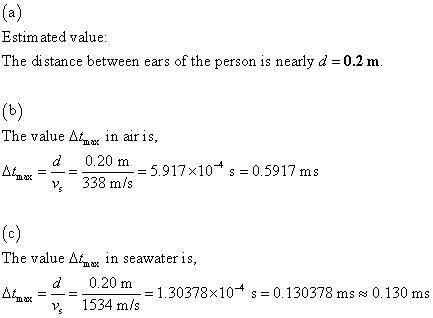
When you hear a noise, you usually know the direction from which it came even if you cannot see the source. This ability is partly because you have hearing in two ears. Imagine a noise from a source that is directly to your right. The sound reaches your right ear before it reaches your left ear. Your brain interprets this extra travel time (Δt) to your left ear and identifies the source as being directly to your right. In this simple model, the extra travel time is maximal for a source located directly to your right or left (Δt = Δtmax). A source directly behind or in front of you has equal travel time to each ear, so Δt = 0. Sources at other locations have intermediate extra travel times (0 ≤ Δt ≤ Δtmax). Assume a source is directly to your right.(a) Estimate the distance between a person's ears. (they gave us the answer of .2... apparently the program is messed up and we have to use .2(b) If the speed of sound in air at room temperature is vs = 338 m/s, find Δtmax. (Use your estimate.)
(c) Find Δtmax if instead you and the source are in seawater at the same temperature, where vs = 1534 m/s. (Use your estimate.)

Answers: 2
Another question on Physics

Physics, 21.06.2019 17:10
An air-standard stirling cycle operates with a maximum pressure of 600 psia and a minimum pressure of 10 psia. the maximum volume of the air is 10 times the minimum volume. the temperature during the heat rejection process is 100°f. calculate the specific heat added to and rejected by this cycle, as well as the net specific work produced by the cycle. use constant specific heats at room temperature. the properties of air at room temperature are r
Answers: 2

Physics, 21.06.2019 23:10
6–55 refrigerant-134a enters the condenser of a residential heat pump at 800 kpa and 358c at a rate of 0.018 kg/s and leaves at 800 kpa as a saturated liquid. if the compressor consumes 1.2 kw of power, determine (a) the cop of the heat pump and (b) the rate of heat absorption from the outside air.
Answers: 2

Physics, 22.06.2019 00:30
Next a skier is pulled by a tow rope up a frictionless ski slope that makes an angle of 15 with the horizontal. the rope moves parallel to the slope with a constant speed of 0.69 m/s. the force of the rope does 800 3 of work on the skier as the skier moves a distance of 8.4 m up the incline. (a) if the rope moved with a constant speed of 2.2 m/s how much work would the force of the rope do on the skier as the skler moved a distance of 8.4 m up the incline? at what rate is the force of the rope doing work on the skier when the rope moves with a speed of (b) 0.69 m/s and (c) 2.2 m/s?
Answers: 1

Physics, 22.06.2019 11:20
How to tell if a molecule is polar or nonpolar with electronegativity
Answers: 2
You know the right answer?
When you hear a noise, you usually know the direction from which it came even if you cannot see the...
Questions

Mathematics, 11.03.2021 22:50

Biology, 11.03.2021 22:50



Mathematics, 11.03.2021 22:50

Mathematics, 11.03.2021 22:50

Chemistry, 11.03.2021 22:50

Mathematics, 11.03.2021 22:50

History, 11.03.2021 22:50

Mathematics, 11.03.2021 22:50





Arts, 11.03.2021 22:50

Mathematics, 11.03.2021 22:50

History, 11.03.2021 22:50

Mathematics, 11.03.2021 22:50





